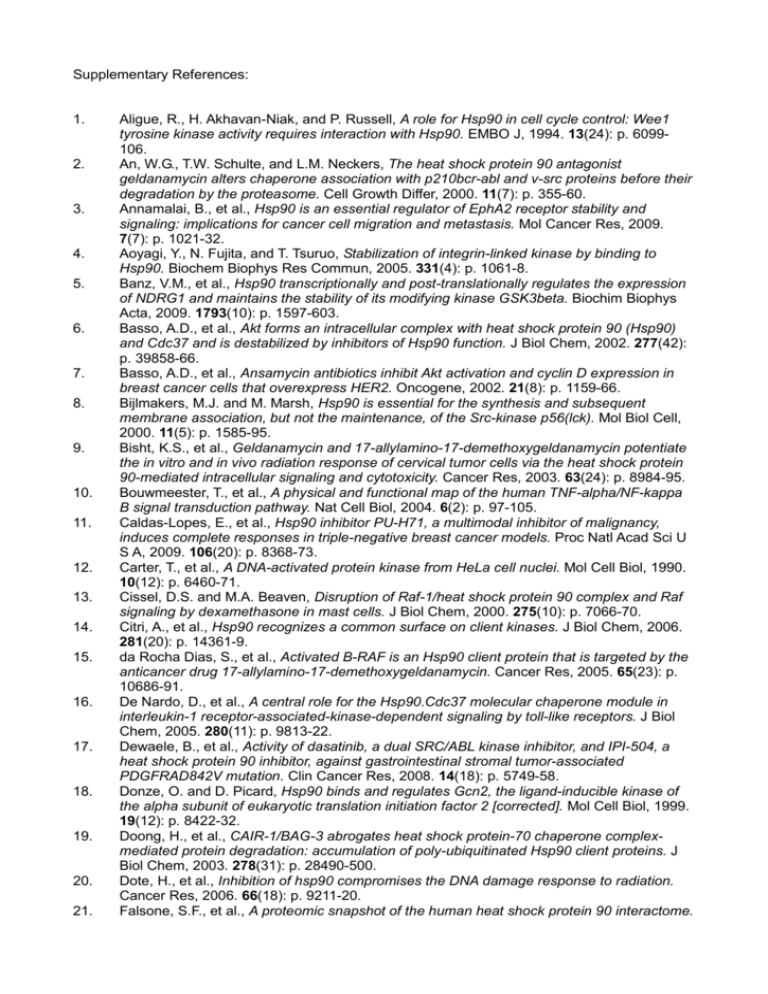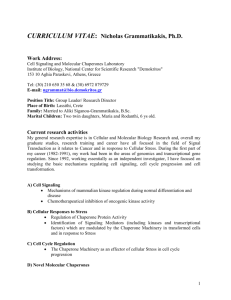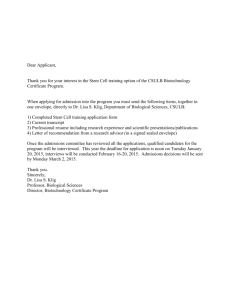Supplementary References:
advertisement

Supplementary References: 1. 2. 3. 4. 5. 6. 7. 8. 9. 10. 11. 12. 13. 14. 15. 16. 17. 18. 19. 20. 21. Aligue, R., H. Akhavan-Niak, and P. Russell, A role for Hsp90 in cell cycle control: Wee1 tyrosine kinase activity requires interaction with Hsp90. EMBO J, 1994. 13(24): p. 6099106. An, W.G., T.W. Schulte, and L.M. Neckers, The heat shock protein 90 antagonist geldanamycin alters chaperone association with p210bcr-abl and v-src proteins before their degradation by the proteasome. Cell Growth Differ, 2000. 11(7): p. 355-60. Annamalai, B., et al., Hsp90 is an essential regulator of EphA2 receptor stability and signaling: implications for cancer cell migration and metastasis. Mol Cancer Res, 2009. 7(7): p. 1021-32. Aoyagi, Y., N. Fujita, and T. Tsuruo, Stabilization of integrin-linked kinase by binding to Hsp90. Biochem Biophys Res Commun, 2005. 331(4): p. 1061-8. Banz, V.M., et al., Hsp90 transcriptionally and post-translationally regulates the expression of NDRG1 and maintains the stability of its modifying kinase GSK3beta. Biochim Biophys Acta, 2009. 1793(10): p. 1597-603. Basso, A.D., et al., Akt forms an intracellular complex with heat shock protein 90 (Hsp90) and Cdc37 and is destabilized by inhibitors of Hsp90 function. J Biol Chem, 2002. 277(42): p. 39858-66. Basso, A.D., et al., Ansamycin antibiotics inhibit Akt activation and cyclin D expression in breast cancer cells that overexpress HER2. Oncogene, 2002. 21(8): p. 1159-66. Bijlmakers, M.J. and M. Marsh, Hsp90 is essential for the synthesis and subsequent membrane association, but not the maintenance, of the Src-kinase p56(lck). Mol Biol Cell, 2000. 11(5): p. 1585-95. Bisht, K.S., et al., Geldanamycin and 17-allylamino-17-demethoxygeldanamycin potentiate the in vitro and in vivo radiation response of cervical tumor cells via the heat shock protein 90-mediated intracellular signaling and cytotoxicity. Cancer Res, 2003. 63(24): p. 8984-95. Bouwmeester, T., et al., A physical and functional map of the human TNF-alpha/NF-kappa B signal transduction pathway. Nat Cell Biol, 2004. 6(2): p. 97-105. Caldas-Lopes, E., et al., Hsp90 inhibitor PU-H71, a multimodal inhibitor of malignancy, induces complete responses in triple-negative breast cancer models. Proc Natl Acad Sci U S A, 2009. 106(20): p. 8368-73. Carter, T., et al., A DNA-activated protein kinase from HeLa cell nuclei. Mol Cell Biol, 1990. 10(12): p. 6460-71. Cissel, D.S. and M.A. Beaven, Disruption of Raf-1/heat shock protein 90 complex and Raf signaling by dexamethasone in mast cells. J Biol Chem, 2000. 275(10): p. 7066-70. Citri, A., et al., Hsp90 recognizes a common surface on client kinases. J Biol Chem, 2006. 281(20): p. 14361-9. da Rocha Dias, S., et al., Activated B-RAF is an Hsp90 client protein that is targeted by the anticancer drug 17-allylamino-17-demethoxygeldanamycin. Cancer Res, 2005. 65(23): p. 10686-91. De Nardo, D., et al., A central role for the Hsp90.Cdc37 molecular chaperone module in interleukin-1 receptor-associated-kinase-dependent signaling by toll-like receptors. J Biol Chem, 2005. 280(11): p. 9813-22. Dewaele, B., et al., Activity of dasatinib, a dual SRC/ABL kinase inhibitor, and IPI-504, a heat shock protein 90 inhibitor, against gastrointestinal stromal tumor-associated PDGFRAD842V mutation. Clin Cancer Res, 2008. 14(18): p. 5749-58. Donze, O. and D. Picard, Hsp90 binds and regulates Gcn2, the ligand-inducible kinase of the alpha subunit of eukaryotic translation initiation factor 2 [corrected]. Mol Cell Biol, 1999. 19(12): p. 8422-32. Doong, H., et al., CAIR-1/BAG-3 abrogates heat shock protein-70 chaperone complexmediated protein degradation: accumulation of poly-ubiquitinated Hsp90 client proteins. J Biol Chem, 2003. 278(31): p. 28490-500. Dote, H., et al., Inhibition of hsp90 compromises the DNA damage response to radiation. Cancer Res, 2006. 66(18): p. 9211-20. Falsone, S.F., et al., A proteomic snapshot of the human heat shock protein 90 interactome. 22. 23. 24. 25. 26. 27. 28. 29. 30. 31. 32. 33. 34. 35. 36. 37. 38. 39. 40. 41. 42. 43. FEBS Lett, 2005. 579(28): p. 6350-4. Fang, S., et al., Heat shock protein 90 regulates the stability of MEKK3 in HEK293 cells. Cell Immunol, 2009. 259(1): p. 49-55. Fujita, N., et al., Involvement of Hsp90 in signaling and stability of 3-phosphoinositidedependent kinase-1. J Biol Chem, 2002. 277(12): p. 10346-53. Fukuyo, Y., et al., Oxidative stress plays a critical role in inactivating mutant BRAF by geldanamycin derivatives. Cancer Res, 2008. 68(15): p. 6324-30. Futami, M., et al., RNAi-mediated silencing of p190Bcr-Abl inactivates Stat5 and cooperates with imatinib mesylate and 17-allylamino-17-demetoxygeldanamycin in selective killing of p190Bcr-Abl-expressing leukemia cells. Leukemia, 2008. 22(6): p. 11318. Gano, J.J. and J.A. Simon, A proteomic investigation of ligand-dependent HSP90 complexes reveals CHORDC1 as a novel ADP-dependent HSP90-interacting protein. Mol Cell Proteomics, 2010. 9(2): p. 255-70. Garcia-Morales, P., et al., Inhibition of Hsp90 function by ansamycins causes downregulation of cdc2 and cdc25c and G(2)/M arrest in glioblastoma cell lines. Oncogene, 2007. 26(51): p. 7185-93. Germano, S., et al., Geldanamycins trigger a novel Ron degradative pathway, hampering oncogenic signaling. J Biol Chem, 2006. 281(31): p. 21710-9. Goes, F.S. and J. Martin, Hsp90 chaperone complexes are required for the activity and stability of yeast protein kinases Mik1, Wee1 and Swe1. Eur J Biochem, 2001. 268(8): p. 2281-9. Gould, C.M., et al., The chaperones Hsp90 and Cdc37 mediate the maturation and stabilization of protein kinase C through a conserved PXXP motif in the C-terminal tail. J Biol Chem, 2009. 284(8): p. 4921-35. Grbovic, O.M., et al., V600E B-Raf requires the Hsp90 chaperone for stability and is degraded in response to Hsp90 inhibitors. Proc Natl Acad Sci U S A, 2006. 103(1): p. 5762. Hartson, S.D., et al., Hsp90-mediated folding of the lymphoid cell kinase p56lck. Biochemistry, 1996. 35(41): p. 13451-9. Hikri, E., S. Shpungin, and U. Nir, Hsp90 and a tyrosine embedded in the Hsp90 recognition loop are required for the Fer tyrosine kinase activity. Cell Signal, 2009. 21(4): p. 588-96. Hutchison, K.A., et al., Reconstitution of the multiprotein complex of pp60src, hsp90, and p50 in a cell-free system. J Biol Chem, 1992. 267(5): p. 2902-8. Imamura, T., et al., Involvement of heat shock protein 90 in the degradation of mutant insulin receptors by the proteasome. J Biol Chem, 1998. 273(18): p. 11183-8. Jaiswal, R.K., et al., Nerve growth factor-mediated activation of the mitogen-activated protein (MAP) kinase cascade involves a signaling complex containing B-Raf and HSP90. J Biol Chem, 1996. 271(39): p. 23626-9. Kawabe, M., et al., Heat shock protein 90 inhibitor 17-dimethylaminoethylamino-17demethoxygeldanamycin enhances EphA2+ tumor cell recognition by specific CD8+ T cells. Cancer Res, 2009. 69(17): p. 6995-7003. Kudlicki, W., et al., Identification of spectrin-related peptides associated with the reticulocyte heme-controlled alpha subunit of eukaryotic translational initiation factor 2 kinase and of Mr 95,000 peptide that appears to be the catalytic subunit. J Biol Chem, 1987. 262(20): p. 9695-701. Lamphere, L., et al., Interaction between Cdc37 and Cdk4 in human cells. Oncogene, 1997. 14(16): p. 1999-2004. Lang, S.A., et al., Targeting heat-shock protein 90 improves efficacy of rapamycin in a model of hepatocellular carcinoma in mice. Hepatology, 2009. 49(2): p. 523-32. Lange, B.M., et al., Cdc37 is essential for chromosome segregation and cytokinesis in higher eukaryotes. EMBO J, 2002. 21(20): p. 5364-74. Lavictoire, S.J., et al., Interaction of Hsp90 with the nascent form of the mutant epidermal growth factor receptor EGFRvIII. J Biol Chem, 2003. 278(7): p. 5292-9. Lees-Miller, S.P. and C.W. Anderson, Two human 90-kDa heat shock proteins are phosphorylated in vivo at conserved serines that are phosphorylated in vitro by casein 44. 45. 46. 47. 48. 49. 50. 51. 52. 53. 54. 55. 56. 57. 58. 59. 60. 61. 62. 63. 64. 65. 66. 67. kinase II. J Biol Chem, 1989. 264(5): p. 2431-7. Lees-Miller, S.P. and C.W. Anderson, The human double-stranded DNA-activated protein kinase phosphorylates the 90-kDa heat-shock protein, hsp90 alpha at two NH2-terminal threonine residues. J Biol Chem, 1989. 264(29): p. 17275-80. Li, R., et al., Hsp90 increases LIM kinase activity by promoting its homo-dimerization. FASEB J, 2006. 20(8): p. 1218-20. Lipsich, L.A., J.R. Cutt, and J.S. Brugge, Association of the transforming proteins of Rous, Fujinami, and Y73 avian sarcoma viruses with the same two cellular proteins. Mol Cell Biol, 1982. 2(7): p. 875-80. Lochhead, P.A., et al., A chaperone-dependent GSK3beta transitional intermediate mediates activation-loop autophosphorylation. Mol Cell, 2006. 24(4): p. 627-33. Lowenberg, M., et al., Glucocorticoids cause rapid dissociation of a T-cell-receptorassociated protein complex containing LCK and FYN. EMBO Rep, 2006. 7(10): p. 1023-9. Matei, D., et al., The platelet-derived growth factor receptor alpha is destabilized by geldanamycins in cancer cells. J Biol Chem, 2007. 282(1): p. 445-53. Maulik, G., et al., Modulation of the c-Met/hepatocyte growth factor pathway in small cell lung cancer. Clin Cancer Res, 2002. 8(2): p. 620-7. McCleese, J.K., et al., The novel HSP90 inhibitor STA-1474 exhibits biologic activity against osteosarcoma cell lines. Int J Cancer, 2009. 125(12): p. 2792-801. Metchat, A., et al., Mammalian heat shock factor 1 is essential for oocyte meiosis and directly regulates Hsp90alpha expression. J Biol Chem, 2009. 284(14): p. 9521-8. Miyata, Y., et al., Specific association of a set of molecular chaperones including HSP90 and Cdc37 with MOK, a member of the mitogen-activated protein kinase superfamily. J Biol Chem, 2001. 276(24): p. 21841-8. Miyata, Y. and E. Nishida, CK2 controls multiple protein kinases by phosphorylating a kinase-targeting molecular chaperone, Cdc37. Mol Cell Biol, 2004. 24(9): p. 4065-74. Miyata, Y. and I. Yahara, The 90-kDa heat shock protein, HSP90, binds and protects casein kinase II from self-aggregation and enhances its kinase activity. J Biol Chem, 1992. 267(10): p. 7042-7. Miyata, Y. and I. Yahara, Interaction between casein kinase II and the 90-kDa stress protein, HSP90. Biochemistry, 1995. 34(25): p. 8123-9. Moran, D.M., et al., Geldanamycin promotes premature mitotic entry and micronucleation in irradiated p53/p21 deficient colon carcinoma cells. Oncogene, 2008. 27(42): p. 5567-77. Nair, S.C., et al., A pathway of multi-chaperone interactions common to diverse regulatory proteins: estrogen receptor, Fes tyrosine kinase, heat shock transcription factor Hsf1, and the aryl hydrocarbon receptor. Cell Stress Chaperones, 1996. 1(4): p. 237-50. Nakashima, T., et al., New molecular and biological mechanism of antitumor activities of KW-2478, a novel nonansamycin heat shock protein 90 inhibitor, in multiple myeloma cells. Clin Cancer Res, 2010. 16(10): p. 2792-802. Nieto-Miguel, T., et al., Proapoptotic role of Hsp90 by its interaction with c-Jun N-terminal kinase in lipid rafts in edelfosine-mediated antileukemic therapy. Oncogene, 2008. 27(12): p. 1779-87. Nimmanapalli, R., et al., Regulation of 17-AAG-induced apoptosis: role of Bcl-2, Bcl-XL, and Bax downstream of 17-AAG-mediated down-regulation of Akt, Raf-1, and Src kinases. Blood, 2003. 102(1): p. 269-75. Ochel, H.J., et al., The benzoquinone ansamycin geldanamycin stimulates proteolytic degradation of focal adhesion kinase. Mol Genet Metab, 1999. 66(1): p. 24-30. O'Keeffe, B., et al., Requirement for a kinase-specific chaperone pathway in the production of a Cdk9/cyclin T1 heterodimer responsible for P-TEFb-mediated tat stimulation of HIV-1 transcription. J Biol Chem, 2000. 275(1): p. 279-87. Ota, A., et al., Specific regulation of noncanonical p38alpha activation by Hsp90-Cdc37 chaperone complex in cardiomyocyte. Circ Res, 2010. 106(8): p. 1404-12. Park, J.H., et al., Inhibitors of histone deacetylases induce tumor-selective cytotoxicity through modulating Aurora-A kinase. J Mol Med, 2008. 86(1): p. 117-28. Prince, T., L. Sun, and R.L. Matts, Cdk2: a genuine protein kinase client of Hsp90 and Cdc37. Biochemistry, 2005. 44(46): p. 15287-95. Ramos, R.R., A.J. Swanson, and J. Bass, Calreticulin and Hsp90 stabilize the human 68. 69. 70. 71. 72. 73. 74. 75. 76. 77. 78. 79. 80. 81. 82. 83. 84. 85. 86. 87. 88. insulin receptor and promote its mobility in the endoplasmic reticulum. Proc Natl Acad Sci U S A, 2007. 104(25): p. 10470-5. Rose, D.W., et al., The 90-kilodalton peptide of the heme-regulated eIF-2 alpha kinase has sequence similarity with the 90-kilodalton heat shock protein. Biochemistry, 1987. 26(21): p. 6583-7. Sawai, A., et al., Inhibition of Hsp90 down-regulates mutant epidermal growth factor receptor (EGFR) expression and sensitizes EGFR mutant tumors to paclitaxel. Cancer Res, 2008. 68(2): p. 589-96. Scholz, G.M., et al., The molecular chaperone Hsp90 is required for signal transduction by wild-type Hck and maintenance of its constitutively active counterpart. Cell Growth Differ, 2001. 12(8): p. 409-17. Schulte, T.W., et al., Destabilization of Raf-1 by geldanamycin leads to disruption of the Raf-1-MEK-mitogen-activated protein kinase signalling pathway. Mol Cell Biol, 1996. 16(10): p. 5839-45. Setalo, G., Jr., et al., Estradiol-induced phosphorylation of ERK1/2 in explants of the mouse cerebral cortex: the roles of heat shock protein 90 (Hsp90) and MEK2. J Neurobiol, 2002. 50(1): p. 1-12. Shang, L. and T.B. Tomasi, The heat shock protein 90-CDC37 chaperone complex is required for signaling by types I and II interferons. J Biol Chem, 2006. 281(4): p. 1876-84. Shimamura, T., et al., Epidermal growth factor receptors harboring kinase domain mutations associate with the heat shock protein 90 chaperone and are destabilized following exposure to geldanamycins. Cancer Res, 2005. 65(14): p. 6401-8. Suttitanamongkol, S., R. Polanowska-Grabowska, and A.R. Gear, Heat-shock protein 90 complexes in resting and thrombin-activated platelets. Biochem Biophys Res Commun, 2002. 297(1): p. 129-33. Taherian, A., P.H. Krone, and N. Ovsenek, A comparison of Hsp90alpha and Hsp90beta interactions with cochaperones and substrates. Biochem Cell Biol, 2008. 86(1): p. 37-45. Takata, Y., et al., Functional importance of heat shock protein 90 associated with insulin receptor on insulin-stimulated mitogenesis. Biochem Biophys Res Commun, 1997. 237(2): p. 345-7. Trentin, L., et al., Geldanamycin-induced Lyn dissociation from aberrant Hsp90-stabilized cytosolic complex is an early event in apoptotic mechanisms in B-chronic lymphocytic leukemia. Blood, 2008. 112(12): p. 4665-74. Tse, A.N., et al., 90-kDa heat shock protein inhibition abrogates the topoisomerase I poisoninduced G2/M checkpoint in p53-null tumor cells by depleting Chk1 and Wee1. Mol Pharmacol, 2009. 75(1): p. 124-33. Uma, S., et al., Hsp90 is obligatory for the heme-regulated eIF-2alpha kinase to acquire and maintain an activable conformation. J Biol Chem, 1997. 272(17): p. 11648-56. Wang, Y., et al., Cotreatment with panobinostat and JAK2 inhibitor TG101209 attenuates JAK2V617F levels and signaling and exerts synergistic cytotoxic effects against human myeloproliferative neoplastic cells. Blood, 2009. 114(24): p. 5024-33. Webb, C.P., et al., The geldanamycins are potent inhibitors of the hepatocyte growth factor/scatter factor-met-urokinase plasminogen activator-plasmin proteolytic network. Cancer Res, 2000. 60(2): p. 342-9. Wrighton, K.H., X. Lin, and X.H. Feng, Critical regulation of TGFbeta signaling by Hsp90. Proc Natl Acad Sci U S A, 2008. 105(27): p. 9244-9. Xie, Q., et al., Geldanamycins exquisitely inhibit HGF/SF-mediated tumor cell invasion. Oncogene, 2005. 24(23): p. 3697-707. Yang, K., et al., Hsp90 regulates activation of interferon regulatory factor 3 and TBK-1 stabilization in Sendai virus-infected cells. Mol Biol Cell, 2006. 17(3): p. 1461-71. Yang, W., et al., Interaction of activated Cdc42-associated tyrosine kinase ACK2 with HSP90. Biochem J, 2004. 382(Pt 1): p. 199-204. Yorgin, P.D., et al., Effects of geldanamycin, a heat-shock protein 90-binding agent, on T cell function and T cell nonreceptor protein tyrosine kinases. J Immunol, 2000. 164(6): p. 2915-23. Yun, B.G. and R.L. Matts, Differential effects of Hsp90 inhibition on protein kinases regulating signal transduction pathways required for myoblast differentiation. Exp Cell Res, 89. 90. 91. 92. 93. 94. 95. 96. 97. 98. 99. 2005. 307(1): p. 212-23. Yun, C.H., et al., Geldanamycin inhibits TGF-beta signaling through induction of Hsp70. Arch Biochem Biophys, 2010. 495(1): p. 8-13. Zhang, H., et al., Hsp90/p50cdc37 is required for mixed-lineage kinase (MLK) 3 signaling. J Biol Chem, 2004. 279(19): p. 19457-63. Ziemiecki, A., et al., Association of the heat shock protein hsp90 with steroid hormone receptors and tyrosine kinase oncogene products. Biochem Biophys Res Commun, 1986. 138(3): p. 1298-307. Hartson, S.D. and R.L. Matts, Association of Hsp90 with cellular Src-family kinases in a cell-free system correlates with altered kinase structure and function. Biochemistry, 1994. 33(30): p. 8912-20. Ramensky V et al., Human non-synonymous SNPs: server and survey. Nucleic Acids Res, 2002. 30(17): 3894-900 Schwarz J.M. Et al., MutationTaster evaluates disease causing potential of sequence alterations. Nat Methods, 2010. 7(8): p. 575-6. Peri, S. et al., Development of human protein reference database as an initial platform for approaching systems biology in humans. Genome Research, 2003. 13: p. 2363-2371. Prasad, T. S. K. et al., Human Protein Reference Database - 2009 update. Nucleic Acids Research, 2009. 37: D767-D772. Stark C. et al., BioGRID: a general repository for interaction datasets. Nucleic Acids Res, 2006. 34: D535-9. Breitkreutz B.J. et al., The BioGRID Interaction Database: 2008 update. Nucleic Acids Res, 2008. 36: D637-40. Savitski M.M. et al., Targeted data acquisition for improved reproducibility and robustness of proteomic mass spectrometry assays. J Am Soc Mass Spectrom., 2010. 21(10): p. 1668-79. Epub 2010 Jan 25.


![[supplementary informantion] New non](http://s3.studylib.net/store/data/007296005_1-28a4e2f21bf84c1941e2ba22e0c121c1-300x300.png)




